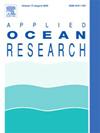Integrated path planning for AUV communication efficiency and obstacle avoidance based on ant colony optimization and three-dimensional dynamic window algorithm
IF 4.3
2区 工程技术
Q1 ENGINEERING, OCEAN
引用次数: 0
Abstract
In tasks such as deep-sea exploration, underwater resource surveying, and archaeological excavation, autonomous underwater vehicles (AUVs) significantly improve the success rate of missions while lowering costs and safety risks. However, AUVs encounter challenges such as poor communication environments, low acoustic communication rates, and dynamic obstacle avoidance during underwater operations. To tackle these issues, this study proposes a multiobjective path planning approach that involves combining improved ant colony optimization (ACO) with a three-dimensional (3D) dynamic window approach (DWA) to optimize the global path planning of AUVs while avoiding obstacles and minimizing path length and communication propagation loss. By introducing nondominated sorting, enhanced heuristic functions, and pheromone update rules, the improved 3D ACO algorithm successfully solves multiobjective optimization problems and balances path length and propagation loss. Moreover, by incorporating the improved 3D-DWA method, the AUV can dynamically avoid obstacles in real time based on the global route supplied by the 3D ACO, guaranteeing safe navigation in dynamic marine environments. By allocating diverse weights to the pitch velocity regions in the DWA method, AUVs can respond to dynamic obstacles in the environment more flexibly, further increasing mission efficiency and safety. Experimental results show that compared with the traditional methods, this method demonstrates significant benefits in terms of path length and communication efficiency, stressing its potential application in complex marine environments.
基于蚁群优化和三维动态窗口算法的AUV通信效率和避障综合路径规划
在深海勘探、水下资源调查和考古挖掘等任务中,自主水下航行器(auv)在降低成本和安全风险的同时,显著提高了任务成功率。然而,在水下作业过程中,auv遇到了诸如恶劣的通信环境、低声通信速率和动态避障等挑战。为了解决这些问题,本研究提出了一种多目标路径规划方法,该方法将改进的蚁群优化(ACO)与三维动态窗口方法(DWA)相结合,以优化auv的全局路径规划,同时避开障碍物,最小化路径长度和通信传播损失。通过引入非支配排序、增强启发式函数和信息素更新规则,改进的三维蚁群算法成功地解决了多目标优化问题,平衡了路径长度和传播损失。此外,结合改进的3D- dwa方法,AUV可以根据三维蚁群算法提供的全局航路实时动态避障,保证在动态海洋环境下的安全航行。DWA方法通过对俯仰速度区域分配不同的权值,使auv能够更加灵活地响应环境中的动态障碍物,从而提高任务效率和安全性。实验结果表明,与传统方法相比,该方法在路径长度和通信效率方面具有显著优势,强调了其在复杂海洋环境中的应用潜力。
本文章由计算机程序翻译,如有差异,请以英文原文为准。
求助全文
约1分钟内获得全文
求助全文
来源期刊

Applied Ocean Research
地学-工程:大洋
CiteScore
8.70
自引率
7.00%
发文量
316
审稿时长
59 days
期刊介绍:
The aim of Applied Ocean Research is to encourage the submission of papers that advance the state of knowledge in a range of topics relevant to ocean engineering.
 求助内容:
求助内容: 应助结果提醒方式:
应助结果提醒方式:


